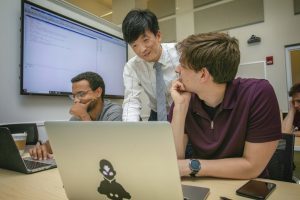
Cray ARM-based System ‘Ookami’ to Serve as Testbed for Computational Studies at Stony Brook
STONY BROOK, N.Y., August 16, 2019 – A $5 million grant from the National Science Foundation (NSF) to the Institute of Advanced Computational Science (IACS) at Stony Brook University will enable researchers nationwide to test future supercomputing technologies and advance computational and data-driven research on the world’s most pressing challenges.
Serving as a testbed for advanced computer technologies, the Ookami system is expected to signal a new generation of high-speed U.S. supercomputers. Using a Cray ARM-based system, Ookami will deliver remarkably high performance for scientific applications, in part due to its blazing-fast memory. Robert J. Harrison, PhD, professor of applied mathematics and statistics and director of IACS, expects that these advanced technologies will enable researchers to more quickly and effectively conduct computational investigations. The project is led by IACS faculty in partnership with co-PI Matt Jones, PhD at the State University of New York at Buffalo, whose team will lead the capture of detailed operational metrics and provision of extensive analytical capabilities. At Stony Brook, co-PI Barbara Chapman, PhD, Department of Computer Science, studies programming models for parallel computing and scalable machine learning; and co-PI Alan Calder, PhD, Department of Physics and Astronomy, whose research in the field of nuclear astrophysics demands massive calculations to explore bright stellar explosions known as Type Ia supernovae.

Il Memming Park, PhD, assistant professor of Neurobiology and Behavior, meets with graduate students at the Institute for Advanced Computational Science to develop computationally efficient optimization techniques for modeling brain function. Through advanced computation, Park’s research is redefining the way that scientists analyze the dynamics of the brain. By analyzing large-scale physiological neural data collected from neural systems, Park examines how information is encoded as spatiotemporal patterns of neural activity, as well as how information is processed to perform specific computations within and across brain areas. Image courtesy of Stony Brook University.
“Research in computational science has increasingly defined the next major frontiers for discovery and innovation. This grant gives us the opportunity to imagine, refine, and develop a new generation of supercomputing technology. It is also a testament to the quality of our researchers — colleagues who stand truly at the cutting-edges of advanced computational science,” said Michael A. Bernstein, Interim President of Stony Brook University.
“Supercomputing only moves forward, and by implementing the Ookami computer system within the IACS, our computational resources for research jump to yet another higher level,” said Harrison. “This project will help researchers to better understand new computing technologies, and thus advances their research and international competitiveness.”
The $5 million grant originates from the NSF’s Office of Advanced Cyberinfrastructure (OAC) national awards, a $22.7 million fund in support of organizations that act as service providers for innovative high-performance computing. The OAC investment to the IACS was motivated by a drive to explore new and future computing models and paradigms, particularly in the areas of capacity systems and innovative prototypes or testbeds that deploy novel technologies.
“The capabilities and services these awards will provide will enable the research community to explore new computing models and paradigms,” said Manish Parashar, office director for the OAC. “These awards complement NSF’s long-standing investment in advanced computational infrastructure, providing much-needed support for the full range of innovative computational- and data-intensive research being conducted across all of science and engineering.”
Since 2012, the IACS has led efforts to communicate science, apply high-performance computing to bridge disciplines and enable data-driven research. The institute’s initial funding stemmed from a $10 million anonymous donation, plus matching funds of equal value from the Simons Foundation. For more information about the IACS at Stony Brook University, visit iacs.stonybrook.edu.
About Stony Brook University
Stony Brook University, widely regarded as a SUNY flagship, is going far beyond the expectations of today’s public universities. With more than 26,000 students, 2,700 faculty members, nearly 200,000 alumni, an academic medical center, and 18 NCAA Division I athletic programs, it is one of only four University Center campuses in the State University of New York (SUNY) system. The University embraces its mission to provide comprehensive undergraduate, graduate, and professional education of the highest quality, and has been ranked among the top 35 public universities in the nation by U.S. News & World Report. Fostering a commitment to academic research and intellectual endeavors, Stony Brook’s membership in the Association of American Universities (AAU) places it among the top 62 research institutions in North America. The University’s distinguished faculty have earned esteemed awards such as the Nobel Prize, Pulitzer Prize, Indianapolis Prize for animal conservation, Abel Prize and the inaugural Breakthrough Prize in Mathematics. Part of the management team of Brookhaven National Laboratory of the U.S. Department of Energy, Stony Brook is one of only eight universities that has a role in running a national laboratory. Providing economic growth for neighboring communities and the wider geographic region, the University totals an impressive $7.23 billion in increased economic output on Long Island. Follow us on Facebook (https://www.facebook.com/stonybrooku/) and Twitter (@stonybrooku).
Source: Stony Brook University































